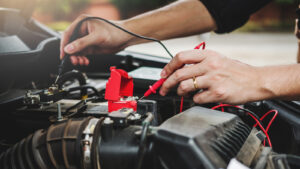Imagine this: You’re examining your car’s engine bay, and it feels like it could win a mud wrestling contest. Grease, dirt, and mysterious residues coat every surface. You think, “I need to clean this,” but the memory of your last attempt at hosing it down haunts you. Water splashed everywhere, electrical components misbehaved, and you feared you’d just voided your warranty.
Introducing the waterless engine wash—an innovative, eco-friendly solution that promises to clean your engine without the chaos. But what is it exactly? And can it be done safely at home? Let’s explore further.
What Is a Waterless Engine Wash?
A waterless engine wash is precisely what its name suggests: a method to clean your car’s engine without using water. It utilizes specialized cleaning products—typically sprays or foams—that dissolve grease, grime, and dirt. Spray it on, allow it to work, and then simply wipe it away.
Think of it as dry shampoo for your car’s engine. It’s fast, convenient, and doesn’t leave a wet mess to clean up.
How Does a Waterless Engine Wash Work?
Let’s delve into the science behind it. Waterless engine cleaners are formulated with robust degreasers and surfactants that dissolve dirt and oil instantly. They are designed to adhere to surfaces, lift grime, and evaporate swiftly, resulting in a spotless, shiny finish.
The Process in a Nutshell
- Spray: Evenly apply the cleaner over the engine bay.
- Wait: Let it sit for a few minutes to break down the grime.
- Wipe: Use a microfiber cloth to remove the dirt and residue.
- Admire: Step back and admire your sparkling clean engine.
Additionally, some products leave a protective coating that prevents future buildup. Quite nifty, right?
Why Choose a Waterless Engine Wash?

If you’re undecided about leaving the hose behind, consider these reasons why waterless engine washes are becoming increasingly popular:
1. No Water, No Problem
Simply put, water and electronics are not friends. Utilizing a waterless cleaner reduces the risk of damaging delicate components like wiring, sensors, or your battery.
2. Eco-Friendly
Traditional engine washing can waste loads of water and introduce harmful chemicals into the environment. Waterless cleaners are typically biodegradable and use minimal resources.
3. Convenience
You don’t need a hose, bucket, or pressure washer. A waterless engine wash can be done anywhere—from your driveway to a parking lot.
4. Time-Saving
It’s quick and easy. You can clean your engine in under 30 minutes, which is far shorter than traditional methods.
Is It Safe to Do a Waterless Engine Wash at Home?
The big question: Is it safe to DIY a waterless engine wash? The short answer is yes—but keep a few things in mind.
1. Follow the Instructions
Each product has its instructions, so read the label carefully. Some cleaners are suitable for all surfaces, while others require caution near specific components.
2. Let the Engine Cool
Avoid spraying anything on a hot engine. Wait for it to cool down to avoid burns or chemical reactions.
3. Cover Sensitive Areas
If you’re cautious (like me), cover electrical connections, the alternator, and the air intake with plastic bags or foil. Better safe than sorry!
4. Use the Right Tools
Microfiber cloths are your best friends here. They’re soft, absorbent, and will not scratch surfaces.
My First Waterless Engine Wash Experience
Allow me to share my first experience with a waterless engine wash. I was skeptical, to put it mildly. My engine bay resembled a dust storm survivor, and I doubted a spray could improve it.
I grabbed a bottle of waterless cleaner, sprayed it on, and waited. Five minutes later, I started wiping it down—and, to my surprise, the dirt just vanished. It was almost magical. No water, no mess, and my engine looked brand new.
Honestly, I felt like a car-detailing wizard.
Common Myths About Waterless Engine Washes
Before you go all out with a waterless cleaner, let’s dispel some myths:
1. “It’s Not as Effective as Water”
False. A quality waterless cleaner can handle even the toughest grime. It’s all about selecting the right product and technique.
2. “It’s Bad for the Environment”
Quite the opposite—many waterless cleaners are eco-friendly and biodegradable. Simply look for those with green certifications.
3. “It’s Too Expensive”
While some products might be pricey, they often prove more cost-effective in the long run. You’re saving water, time, and potentially costly repair bills from water damage.
Step-by-Step Guide to a Waterless Engine Wash

Ready to give it a shot? Here’s a straightforward guide to get you started:
What You’ll Need
- Waterless engine cleaner
- Microfiber cloths
- Soft-bristle brush (optional)
- Plastic bags or foil (optional)
Steps
- Prep the Engine: Allow it to cool thoroughly and cover any sensitive areas.
- Spray the Cleaner: Apply evenly across the engine bay.
- Let It Sit: Allow 5-10 minutes for the cleaner to work.
- Wipe Away: Use a microfiber cloth to remove dirt and residue.
- Buff and Shine: For extra polish, use a dry cloth to buff surfaces.
FAQs About Waterless Engine Washes
1. Can I use a waterless engine wash on any car?
Yes, but always verify the product’s compatibility with your vehicle on the label first.
2. How often should I clean my engine?
Typically every 6-12 months, depending on its condition.
3. Will it remove oil stains?
While it can lighten them, heavy stains may require additional treatment.
4. Is it safe for rubber and plastic parts?
Most waterless cleaners are safe, but test a small area first to be certain.
Final Thoughts
So, is a waterless engine wash safe to do at home? Absolutely—provided you follow the right steps and use the right products. It’s a game-changer for both car enthusiasts and casual drivers.
Honestly, I’ll never return to traditional engine washing. It’s messy, time-consuming, and risky. With a waterless cleaner, I achieve the same results in half the time—without the stress.
Have you tried a waterless engine wash? What was your experience like? Share your thoughts in the comments below!
If you haven’t tried it yet, what are you waiting for? Grab a bottle, roll up your sleeves, and let’s get that engine sparkling.



